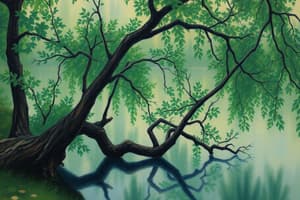Podcast
Questions and Answers
What is the central idea of the poem 'The Flea' by John Donne?
What is the central idea of the poem 'The Flea' by John Donne?
- A symbol of love and romance
- A symbol of innocence and virtue
- The mingling of two bloods and the connection between two people (correct)
- A symbol of experience and the past
What is a common characteristic of authors within a literary movement?
What is a common characteristic of authors within a literary movement?
- They only write in one specific form.
- They never experiment with new styles.
- They come from the same geographical location.
- They share similar ideas and intentions. (correct)
What is essential to consider when interpreting symbols in a literary work?
What is essential to consider when interpreting symbols in a literary work?
- The context in which the symbol is used (correct)
- The historical context of the symbol
- The cultural context of the symbol
- The personal experience of the reader with the symbol
What is a notable feature of metaphysical poetry?
What is a notable feature of metaphysical poetry?
Who is credited with establishing the reputation of metaphysical poets in the twentieth century?
Who is credited with establishing the reputation of metaphysical poets in the twentieth century?
What is the tone of John Donne's poem 'The Flea'?
What is the tone of John Donne's poem 'The Flea'?
What is a characteristic of metaphysical poets, according to Samuel Johnson?
What is a characteristic of metaphysical poets, according to Samuel Johnson?
What is the subject matter of metaphysical poetry?
What is the subject matter of metaphysical poetry?
Who is considered the originator of the metaphysical poetry genre?
Who is considered the originator of the metaphysical poetry genre?
What is a characteristic of the works created within a literary movement?
What is a characteristic of the works created within a literary movement?
What is the term used to describe the poets of the seventeenth century, according to John Dryden and Samuel Johnson?
What is the term used to describe the poets of the seventeenth century, according to John Dryden and Samuel Johnson?
What is the time period during which metaphysical poetry was at its peak?
What is the time period during which metaphysical poetry was at its peak?
Flashcards
Central Idea of 'The Flea'?
Central Idea of 'The Flea'?
The mingling of two bloods and the connection between two people.
Literary Movement Characteristic?
Literary Movement Characteristic?
Sharing similar ideas and intentions in their works.
Interpreting Symbols?
Interpreting Symbols?
The specific context in which the symbol is used.
Metaphysical Poetry Feature?
Metaphysical Poetry Feature?
Signup and view all the flashcards
Metaphysical Poets' Reputation?
Metaphysical Poets' Reputation?
Signup and view all the flashcards
Tone of 'The Flea'?
Tone of 'The Flea'?
Signup and view all the flashcards
Samuel Johnson's Criticism?
Samuel Johnson's Criticism?
Signup and view all the flashcards
Metaphysical Poetry Subject?
Metaphysical Poetry Subject?
Signup and view all the flashcards
Metaphysical Poetry Originator?
Metaphysical Poetry Originator?
Signup and view all the flashcards
Works in Literary Movement?
Works in Literary Movement?
Signup and view all the flashcards
17th-Century Poets' Title?
17th-Century Poets' Title?
Signup and view all the flashcards
Peak of Metaphysical Poetry?
Peak of Metaphysical Poetry?
Signup and view all the flashcards
Study Notes
Metaphysical Poetry
- Emerged in 17th century England and continental Europe
- Characterized by exploration of irony, philosophy, and conceits
- Poets relaxed strict use of meter and explored new ideas
John Donne
- Best-known metaphysical poet
- Famous for his poem "The Flea"
- In "The Flea", Donne's speaker argues that it's fine for two people to sleep together because a flea has fed on both their blood, symbolizing their mingled bloods
Metaphysical Poets
- Include John Donne, Henry Vaughan, Andrew Marvell, and George Herbert
- Donne is often cited as the best of this group and the originator of the genre's basic tenets
Symbolism
- Context is crucial in determining the meaning of symbols
- Symbols can be physical objects or abstract concepts
- Examples of symbols: bracelet, scar, picture, smile, hug, threat
- Meaning of symbols can change depending on the context, such as who possesses the object or the circumstances surrounding it
History of Metaphysical Poetry
- Term "metaphysical" was first used by writers like John Dryden and Samuel Johnson in the 17th century to describe poets of that time
- Not until the 20th century that metaphysical poets were adequately recognized for their talent and originality
- T.S. Eliot was a 20th-century literary critic who helped establish the reputation of metaphysical poets
Literary Movement
- A group of literary works created around the same time by authors with similar intentions and styles
- Can range from essays to poems
- Authors within a movement often write about the same subjects, in the same way, with the same intentions
Studying That Suits You
Use AI to generate personalized quizzes and flashcards to suit your learning preferences.




